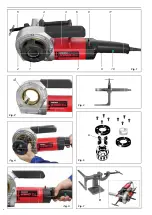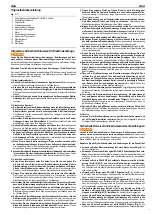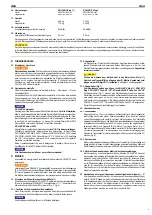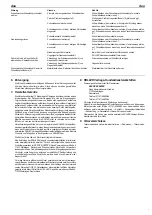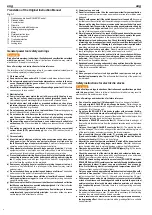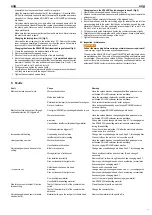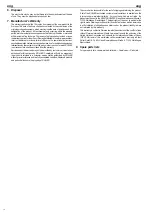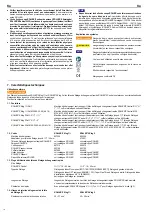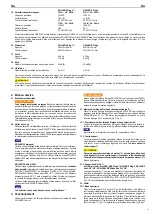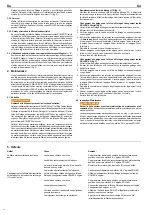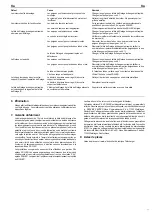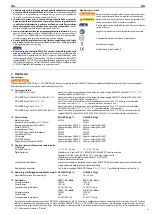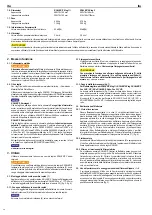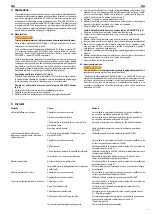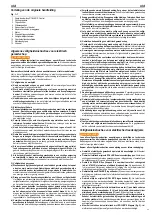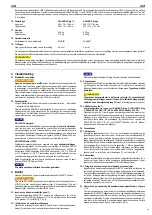
10
2. Start-up
2.1. Electrical connection
WARNING
WARNING
Caution: Mains voltage present!
Caution: Mains volt
Caution: Mains volt
Before connecting the electric die stock,
age present!
age present!
check whether the voltage given on the rating plate corresponds to the mains
voltage. On building sites, in a wet environment, indoors and outdoors or under
similar installation conditions, only operate the electric die stock on the mains
with a fault current protection switch (FI switch) which interrupts the power
supply as soon as the leakage current to earth exceeds 30 mA for 200 ms.
2.2. Thread-cutting materials
For safety data sheets, see www.albert-roller.de → Downloads → Safety Data
Sheets.
Only use ROLLER thread cutting materials. They ensure perfect cutting results,
long life of the dies and considerably relieve stress on the tools. ROLLER
recommends the practical and economical spray can/spray bottle.
NOTICE
NOTICE
ROLLER’S Smaragdol
High-alloy mineral oil-based thread-cutting material.
For all materials: steel,
stainless steel, non-ferrous metals, plastics. Can be washed out with water,
tested by experts. Mineral oil-based thread cutting materials are not approved
for drinking water pipes in different countries, e.g. Germany, Austria and Swit-
zerland. Mineral oil-free ROLLER’S Rubinol 2000 must be used in this case.
Observe the national regulations.
ROLLER’S Rubinol 2000
Mineral oil-free, synthetic thread-cutting material for
drinking water pipes.
Completely soluble in water. According to regulations. In Germany DVGW test
Completely soluble in water. Accor
Completely soluble in water. Accor
no. DW-0201AS2031, Austria ÖVGW test no. W 1.303, Switzerland SVGW
test no. 9009-2496. Viscosity at –10°C: ≤ 250 mPa s (cP). Pumpable up to
–28°C. Easy to use. Dyed red for checking washout. Observe the national
regulations.
Both thread cutting materials are available in aerosol cans, canisters, barrels
as well as spray bottles (ROLLER’S Rubinol 2000).
NOTICE
NOTICE
All thread cutting materials may only be used in undiluted form!
3. Operation
Only use the original ROLLER’S Central quick-change die heads.
WARNING
WARNING
Do not use the ROLLER’S S die heads together with extension (Art.-No. 476035)
with an electric die stock. The counter holder (3) does not fi t. Otherwise there
is a danger of the electric die stock being torn from the hand and spinning round
as the torque increases.
3.1. Inserting the quick-change die heads (1)
Insert ROLLER’S Central quick-change die head in the die head holder (2)or
in the adapter for ROLLER’S die heads up to 1 1¼”/40 mm, turn slightly until
the locking lever (12) locks (Fig. 2, Fig. 4).
3.1.1. Function of the quick-change die heads
On reaching the standard thread length, switch the rotation direction lever (8)
and let the quick-change die head run in reverse direction.
NOTICE
NOTICE
Only operate the rotation direction lever (8) at standstill!
3.1.2. Counter holder
The counter holder (3) serves to support the torque that occurs during thread
cutting in both directions, i.e. in forward and reverse direction of the thread die,
for right and left hand threads.
Always use the counter holder!
CAUTION
CAUTION
Do not reach into the area of the motor (7), pressing and carrying handle
(6) and counter holder (3) during operation. Only hold the electric die
stock by the motor handle (11). There is a risk of injury.
3.1.3. Dual purpose holder (Fig. 7)
For thread cutting and sawing, for ROLLER’S King 1¼, ROLLER’S King 2,
ROLLER’S Fox ANC / VE / SR and ROLLER’S Akku-Fox 22 V VE.
R and ROLLER’S Akku-Fox 22 V VE
R and ROLLER’S Akku-Fox 22 V VE
The dual purpose holder (Fig. 7) is screwed to a workbench and serves to
support the torque which occurs when cutting threads in both directions, i.e. in
support the torque which occur
support the torque which occur
forward and reverse direction of the thread die for right and left hand threads.
The locating pin (B) is provided for holding the ROLLER’S Fox ANC / VE / SR
and ROLLER’S Akku-Fox 22 V VE. Pipes/rods can be cut at right angles.
3.2. Thread cutting
3.2.1. Work procedure
Fix the counter holder (3) approx. 10 cm away from the end of the pipe. Place
the counter holder facing back slightly at an angle with the prism die (4) against
the pipe and tighten fi rmly with the clamping spindle with feed screw. Apply
thread-cutting material to the interface. Place the electric die stock with inserted
quick-change die head on the pipe so that the counter holder (3) comes to rest
between the pressing and carrying handle (6) and the motor (7) (Fig. 1). Set
the rotation direction lever (8) accordingly (R for right hand thread or return for
left hand thread. L for left-hand thread or return for right hand thread). Press
the safety inching switch (9) whilst gripping the motor handle (11) (Fig. 6).
3.2.2. Start cutting
Switch on the electric die stock with the safety switch (9) and press it against
the pipe until the dies have started cutting. Lubricate with ROLLER thread-cut-
ting material several times during thread cutting.
3.2.3. Return and removal of the electric die stock
When using ROLLER’S Central quick-change die heads, the conical pipe thread
is fi nished when the dies are fl ush with the end of the pipe. Release the safety
inching switch (9) immediately. Set the rotation direction lever (8) accordingly
– only actuate the rotation direction lever at standstill. Switch the electric die
stock on at the safety inching switch (9). The quick-change die head turns off
the thread. Set the rotation direction lever again accordingly with the unit at
standstill.
3.3. Handling the manually inside clamping nipple holder Nipparo ⅜ – 2"
To clamp a pipe section with the manually inside clamping nipple holder
ROLLER’S Nipparo the head of the manually inside clamping nipple holder is
splayed by turning the spindle with a tool (e.g. screwdriver). This may only be
done with the pipe inserted. Make sure that no shorter nipples than allowed
are cut with the manually inside clamping nipple holder (Fig. 3).
4. Maintenance
Notwithstanding the maintenance described below, it is recommended to send in
the power tool to an authorised ROLLER contract customer service workshop for
inspection and periodic testing of electrical devices at least once a year. In Germany,
such periodic testing of electrical devices should be performed in accordance with
DIN VDE 0701-0702 and also prescribed for mobile electrical equipment according
to the accident prevention rules DGUV, regulation 3 “Electrical Systems and
Equipment”. In addition, the respective national safety provisions, rules and
regulations valid for the application site must be considered and observed.
4.1. Maintenance
WARNING
WARNING
Pull out the mains plug before maintenance work!
Clean the ROLLER’S King 1¼ and King 2 electric die stocks after every use,
eng eng
1.8. Noise information
ROLLER’S King 1¼
ROLLER’S King 2
Workplace-related emission value
83 dB(A)
83 d
B(
B(
B(A)
B(
B(
1.9. Vibrations
Weighted rms value of acceleration
2.5 m/s²
2.5 m/s²
The specifi ed vibration emission value was measured according to a standard test method and can be used for comparison with another device. The specifi ed vibra-
tion emission value can also be used for an initial estimation of the cut-out.
CAUTION
CAUTION
The vibration emission value may differ from the specifi ed value during actual use of the unit depending on the manner in which the electric die stock is used. Depending
on the actual conditions of use (intermittent mode) , it may be necessary to defi ne safety measures to protect the operator.


